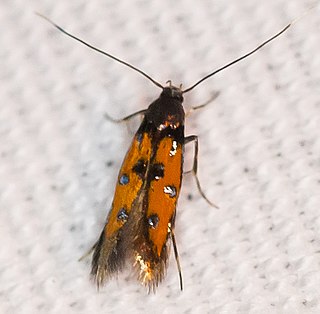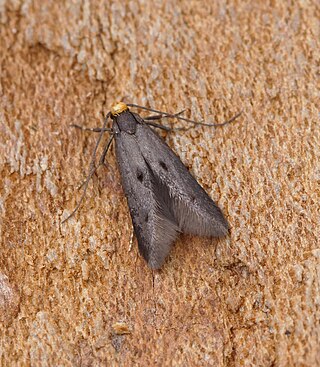
The Agonoxeninae are a subfamily of moths.

The Elachistidae are a family of small moths in the superfamily Gelechioidea. Some authors lump about 3,300 species in eight subfamilies here, but this arrangement almost certainly results in a massively paraphyletic and completely unnatural assemblage, united merely by symplesiomorphies retained from the first gelechioid moths.
Vulcaniella grabowiella is a moth of the family Cosmopterigidae. It is found from the Iberian Peninsula to Asia Minor.

Chrysoclista linneella, is a moth of the family Agonoxenidae found in Europe and North America.

Spuleria is a genus of moths of the family Elachistidae. It contains only one species Spuleria flavicaput, which is found in most of Europe and Anatolia. The larvae mine the twigs of hawthorns.
Chrysoclista is a genus of moths of the family Agonoxenidae described by Henry Tibbats Stainton in 1854.

Chrysoclysta grandis is a species of moth of the family Agonoxenidae. It is found in the western United States, in the mountains of California and Colorado.
Chrysoclista villella is a species of moth of the family Agonoxenidae. It is found in the United States (Washington) and Canada.

Chrysoclista lathamella is a species of moth of the family Agonoxenidae described by Thomas Bainbrigge Fletcher in 1936. It is found in northern Europe.
Chrysoclista splendida is a species of moth of the family Agonoxenidae. It is found in Portugal, France, Germany, Poland, Slovakia, the Czech Republic, Austria, Hungary, Romania, Bulgaria and North Macedonia. There are also records from Sweden.
Dystebenna is a genus of moths of the family Elachistidae. The genus is mostly placed in the family Elachistidae, but other authors list it as a member of the family Agonoxenidae. It contains only one species Dystebenna stephensi, which is found in Asia and Europe.
Chrysoclista zagulajevi is a species of moth of the family Agonoxenidae. It is found in Georgia and Adjara (Transcaucasia).
Chrysoclista abchasica is a species of moth of the family Agonoxenidae. It is found in the Czech Republic, Georgia and Abkhazia (Transcaucasia).
Chrysoclista basiflavella is a moth of the family Agonoxenidae. It was described by Shōnen Matsumura in 1931. It is found in Japan.
Chrysoclista hygrophilella is a moth of the family Agonoxenidae. It was described by Pierre Viette in 1957. It is found on Réunion.
Chrysoclista monotyla is a moth of the family Agonoxenidae. It was described by Edward Meyrick in 1921. It is found in Australia (Queensland).
Chrysoclista thrypsiphila is a moth of the family Agonoxenidae. It was described by Edward Meyrick in 1912. It is found in Sri Lanka.
Chrysoclista trilychna is a moth of the family Agonoxenidae. It was described by Edward Meyrick in 1928. It is found in India (Madras).
Palaeomystella tibouchinae is a moth of the family Agonoxenidae. It is found in Brazil.
Palaeomystella oligophaga is a moth of the family Agonoxenidae. It is found in Brazil.





